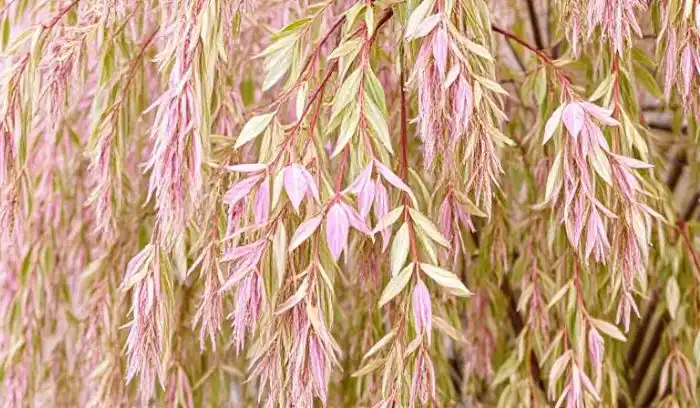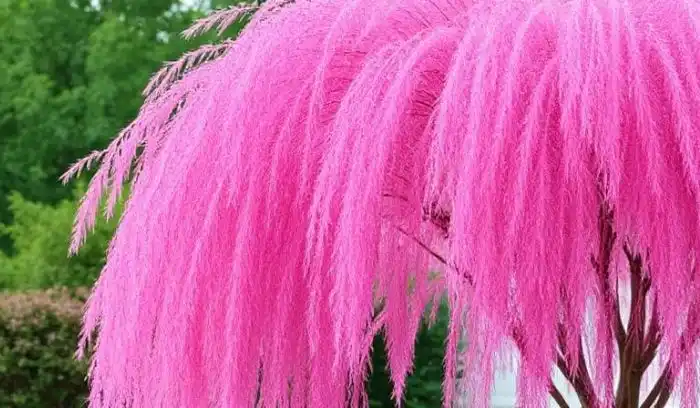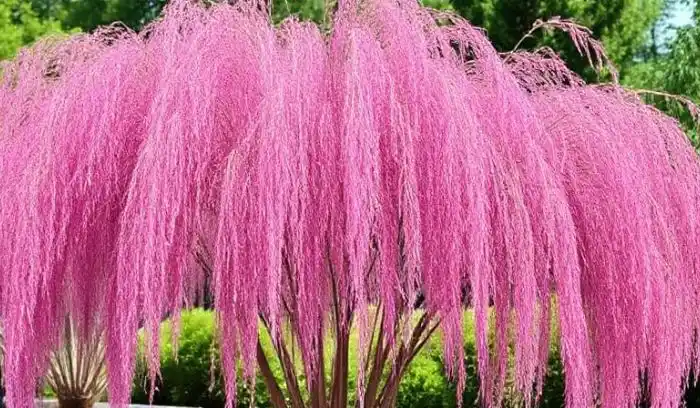The Pink Willow tree, also known as Salix integra ‘Hakuro Nishiki’, is a stunning shrub that can easily be mistaken for a tall tree due to its impressive size. This beautiful willow tree stands out with its striking pink flowers and multi-colored leaves.
The foliage begins in pale pink, transitioning to a mix of green and white over the seasons.
As the seasons change, the green leaves fade and reveal their beautiful winter persona with shades of white and green, making it a visual standout in any garden or landscape. Its cascading branches add elegance and flow, making it a popular choice for creating focal points in outdoor spaces.
For those looking to add this unique tree to their garden, it’s important to understand the optimal growing conditions. The Dappled Willow requires careful watering, as well as regular pruning needs to maintain its beauty.
Whether you are selecting or planting your tree, following a detailed care guide will ensure its healthy growth. As a garden expert, I can say that with proper care, this ornamental tree will thrive and bring an inviting charm to any outdoor space. Its vibrant leaves and pink flowers will certainly make it an unforgettable feature in any garden.
Key Points
| #- | Key Points | Details |
|---|---|---|
| 1- | Common Names | Pink Willow, Dappled Willow, Variegated Willow, Flamingo Willow |
| 2- | Botanical Name | Salix integra ‘Hakuro Nishiki’ |
| 3- | Mature Size | Height: 10-20 feet, Spread: 10-15 feet |
| 4- | Foliage Color | Starts pale pink, transitions to green and white, turns golden yellow in fall |
| 5- | Flowering | Produces catkin flowers in spring, primarily admired for foliage |
| 6- | Growing Conditions | Full sun (6+ hours/day), well-draining, moderately moist, adaptable to soil pH (acidic to alkaline) |
| 7- | Hardiness Zones | 5-9 |
| 8- | Watering Needs | Regular watering, deep watering during the first year, avoid overwatering |
| 9- | Soil Requirements | Loamy, well-draining soils, moisture-retentive but not waterlogged |
| 10- | Pruning | Prune in late winter, remove dead/damaged growth, thin dense branches for better air circulation |
| 11- | Fertilization | Apply balanced, slow-release fertilizer in early spring, avoid late-season fertilization |
| 12- | Pest/Disease Issues | Common problems: leaf spot, powdery mildew, aphids, beetles, root rot, trunk cankers |
| 13- | Key Benefits | Visual appeal, low maintenance, attracts beneficial insects, frost and deer resistant |
| 14- | Planting Tips | Dig a hole 2-3x the root ball width, water thoroughly after planting, space trees 10-15 feet apart |
| 15- | Where to Buy | Online nurseries like Fast Growing Trees, Wilson Bros Gardens, Nature Hills Nursery |
| 16- | Design Use | Focal point tree, near water features, in containers, or as a garden accent near seating areas |
An Overview of the Pink-Flowered Willow Tree

The pink-flowered willow, also known as dappled willow or variegated willow, is a charming deciduous tree from the Salix genus in the willow family (Salicaceae). It’s a cultivar of the famous Pussy Willow, selected for its striking pink new growth.
This ornamental tree grows to mature heights of 10-20 feet tall and spreads about 10-15 feet wide, featuring a rounded form with gracefully arching branches that give it a delicate appearance. Its weeping appearance adds elegance to any landscape, making it an excellent choice for gardens.
During spring, the foliage starts with a soft pale pink, which then transitions to pale green with white variegation as the season progresses. In fall, the leaves turn a beautiful golden yellow, adding to its charm.
The stems also showcase colorful red and yellow hues throughout the year. Although the Salix integra produces catkin flowers in the spring, it’s primarily admired for its vivid foliage. This tree is both frost resistant and deer resistant, making it a practical and stunning addition to any garden.
Growing Conditions for Pink Willow Trees
For optimal growth, Pink Willow trees thrive in full sun exposure. They need at least 6 hours of direct sunlight each day to flourish. While they can tolerate partial shade, the intense leaf coloring that gives these trees their unique beauty is best achieved in bright sunlight.
When selecting a planting site, make sure the soil is moderately moist and well-draining, ideally loamy soils that retain moisture yet allow excess water to drain well, especially after heavy rain. Avoid planting them in areas with dense clay or compacted clay as these soils can hinder proper drainage.
The Pink Willow also tolerates a wide range of soil pH, from acidic to alkaline, and can withstand environmental stress such as drought and salt once the tree is established. It’s essential to maintain evenly moist soil during the growing season, allowing it to dry slightly between waterings.
For sandy soils, you may need to amend the ground with compost or other organic matter to improve moisture retention. While Salix integra is fairly hardy, it’s best suited for hardiness zones 5-9, and trees in exposed areas or windy areas should be given winter protection to thrive year-round.
How to Plant and Care for a Willow Tree with Pink Flowers

Planting
When planting a willow tree with pink flowers, choose a full sun location that has well-draining soil. Begin by digging a hole that is 2-3 times the width of the root ball and equal depth.
Carefully remove the tree from its container and place it gently in the hole, ensuring the top of the root ball is level with the soil surface. After that, backfill the hole with native soil, making sure to tamp it gently to avoid any air pockets.
If planting multiple trees, make sure to space them 10-15 feet apart to accommodate their mature spread. This gives them room to grow and ensures they won’t overcrowd each other. With the right care, your willow tree will thrive and flourish, adding a beautiful touch of color to your garden.
Watering
When planting your willow tree with pink flowers, it’s important to water deeply at least once a week during the first year. This will help moisten the soil to a depth of around 6 inches, ensuring the roots grow strong and healthy.
As the tree establishes itself, you can reduce the frequency, but be mindful of drought conditions. In such cases, the tree may need supplemental water to survive. You can use a soaker hose or drip irrigation system for consistent moisture, which helps avoid overwatering.
Once the tree is established, it’s essential to let the soil partially dry between waterings to prevent issues like root rot. Monitor the moisture levels, particularly during periods of low humidity. With proper care and attention, your tree will thrive and continue to grow strong.
Pruning
When pruning your willow tree with pink flowers, the best time is late winter before new growth starts. Start by removing any dead growth or damaged growth to help your tree stay healthy.
It’s also important to thin out dense branches to improve air circulation and light penetration, which are essential for overall tree health. Cutting back older branches will promote better growth, making sure the tree’s form is maintained and its beauty enhanced.
Every 2-3 years, you may want to consider renewal pruning. This rejuvenates the tree’s growth by cutting back older branches, but always aim to leave a healthy bud above the cut to allow new shoots to emerge. This will keep the tree looking lush and encourage fresh, vibrant blooms year after year.
Fertilization
In early spring, applying a balanced, slow-release fertilizer is essential for the health of your Willow Tree with Pink Flowers. Be sure to follow the label rates carefully to ensure you don’t overdo it. Too much fertilizer, especially excess nitrogen, can encourage leggy growth, making the tree look weak and unbalanced. This can also lead to an unhealthy structure, affecting its overall appearance.
It’s also important to avoid fertilizing after mid-summer. Fertilizing too late in the year can trigger unwanted late season leaf growth, which can weaken the tree as it prepares for winter. Stick to the early season, and you’ll have a tree that thrives with healthy growth all year long.
Pest/Disease Control
To ensure healthy growth for your Willow Tree with Pink Flowers, it’s important to provide proper cultural care to prevent any disease issues.
Regularly inspect your tree to catch common problems like leaf spot, powdery mildew, stem canker, and insect pests before they worsen. If you notice any signs of infection, promptly remove the infected material to stop the spread.
In case the problem persists, it’s crucial to treat the tree with safe methods. Using organic fungicides and insecticidal soaps can help control these issues without harming the tree or the environment. Regular maintenance and early intervention will keep your willow tree healthy and thriving.
Benefits of Growing a Pink Willow Tree

The pink willow tree, also known as Flamingo Willow, offers a range of benefits that make it an excellent choice for any garden. With its striking aesthetic appeal and vibrant pink foliage, it provides a stunning pop of color year-round.
This tree is low maintenance and adaptable to various landscapes. Whether you’re looking to add a focal point in your garden or a unique touch to your outdoor space, the pink willow tree can become a standout feature with its unique color palette and visual interest. It thrives with minimal care and is easy to maintain.
Besides its beauty, the pink willow tree also plays a role in attracting wildlife, including beneficial insects like butterflies and bees. Its graceful weeping form and design versatility allow it to be used as a centerpiece or planted near water features or borders.
The tree thrives in various soil conditions and climates, making it perfect for different regions, while also providing consistent visual interest with its vibrant pink hues throughout the year.
Where to Buy a Pink-Flowered Willow Tree
If you’re looking to buy a pink-flowered willow tree, you may find it somewhat uncommon at garden centers and nurseries. The best option is often buying online from a reputable nursery.
These nurseries offer a variety of ornamental trees like Salix integra, known for its stunning foliage.
When shopping, check for key indicators of a healthy tree, such as robust stems, plentiful leaf buds, and an extensive root system. Avoid trees with broken branches, discolored bark, or roots that are girdling the container.
Consider purchasing young container-grown trees in 1-2 gallon pots or 5-7 gallon sizes. Smaller trees might take a little longer to establish but are easier to transport and plant, while larger trees will fill out faster but need more space.
It’s also a good idea to buy your tree during the dormant season, as bareroot and packaged trees are usually less expensive than potted varieties. Some reputable online sellers, like Fast Growing Trees, Wilson Bros Gardens, and Nature Hills Nursery, offer excellent options. You can choose from varieties like Tri-Color Dappled Willow, which has vivid pink, green, and white foliage, or the Flamingo® Dappled Willow with bright yellow and coral leaves.
For something unique, try the Scarlet Curls® Dappled Willow, which features curly foliage in shades of red, orange, and yellow, or the Japanese Dappled Willow, known for its delicate spring growth.
Designing With Pink Willow Trees

A pink willow can add visual interest to any landscape, whether it’s placed in garden beds, borders, or containers. If you want to create a standout feature, use it as a focal point specimen tree in a sunny island planting bed.
Pair it with plants that have purple or yellow foliage, like coneflowers, to provide a striking contrast. Groups of three trees can make a vibrant and colorful privacy screen or property border, while still allowing light penetration.
For smaller spaces, you can place smaller potted willows on patios or decks in large containers. This brings the tree’s captivating colors up close for maximum impact.
You can also plant them near ponds or water features, where their trailing branches will sway attractively above the water. Use them as a garden accent near seating areas or footpaths, where their pendulous form can be admired up close. These trees make for a beautiful addition to any landscape design.
Common Issues With Willow Trees
Leaf scorch
Leaf scorch is a common issue for willow trees, especially when the leaf margins begin to show signs of browning. This problem usually occurs due to insufficient watering or when the tree is exposed to high winds that dry out the leaves.
To fix this, you can improve the irrigation system to ensure the tree gets enough water. Providing protection against strong winds can also help reduce the damage.
If you notice leaf scorch on your willow tree, addressing these factors quickly will help resolve the issue. Regularly checking the soil moisture and taking steps to shield the tree from extreme weather conditions can prevent further damage and keep your tree healthy.
Powdery mildew
Powdery mildew is a common issue for willow trees, often appearing as a white coating on the leaves and stems. This fungal disease can spread quickly if not addressed early. The best way to manage it is through fungicide treatment, which helps eliminate the mildew from the tree.
Additionally, ensuring proper pruning is done to allow for better air circulation around the tree can prevent the disease from recurring. Regularly inspecting your tree and keeping it well-maintained is crucial to keeping powdery mildew in check.
By improving air circulation and applying the correct fungicide treatment, you can effectively control and reduce the spread of this problem. A little care goes a long way in preserving the health and beauty of your willow tree.
Leaf spot
Leaf spot often shows up as dark spots on the foliage. These spots can spread quickly if not addressed, so it’s best to pick off and destroy any affected leaves as soon as you notice them.
By removing these leaves, you stop the disease from spreading to healthier parts of the tree. Additionally, it’s important to improve drainage around your willow. If there’s excessive moisture, that might be the cause of the problem. Ensuring that water doesn’t sit too long in the soil can go a long way in keeping your willow tree healthy.
Aphids, sawflies, beetles
Aphids, sawflies, and beetles are common insects that can cause damage to your willow tree. These pests chew on the leaves, which can result in weakened growth.
Honeydew secretions from these insects can also make the tree sticky and attract mold. To control infestations, it’s essential to wipe off these insects from the tree regularly and use insecticidal soap sprays for better protection.
If left untreated, these pests can quickly spread and harm the overall health of the tree. Make sure to check your tree often and take preventive measures to control infestations before they get out of hand. Regular care and attention will keep your tree strong and healthy.
Root rot
Root rot is a common issue with willow trees and usually happens when soils don’t drain properly. This can lead to waterlogging, which suffocates the roots and causes decay. To prevent this, it’s important to amend the soil to improve drainage. Avoid overwatering your tree, as this can worsen the problem by keeping the roots in water for too long.
A well-draining soil mix will help your willow tree thrive and prevent root rot from taking hold. Regularly check the soil to ensure it’s not too compacted or waterlogged, as these conditions make it hard for the tree’s roots to breathe.
Trunk cankers
Trunk cankers are a common problem in willow trees. These wounds often develop on the tree’s trunk and can ooze sap, which is a sign of infection. It’s important to remove any affected areas by pruning them carefully. After cutting, make sure to sterilize tools to prevent the spread of disease to healthy parts of the tree. If left untreated, trunk cankers can worsen and harm the tree’s health.
Pay attention to any signs of wounds or sap coming from the trunk and take action quickly. Proper care and regular pruning will help ensure the health of your willow tree and prevent these issues from spreading.
Types of Pink-Flowered Willow Trees
Desert willow
The Desert Willow is a drought-tolerant tree that thrives in dry conditions. It can grow up to 18 feet tall and produces beautiful dark pink flowers that add vibrant color to your garden.
This tree is native to the US and Mexico, and it grows well in USDA zones 6-9, making it ideal for warmer climates. There are several varieties of the Desert Willow, including Desert Diva, Bow Willow, and Chilopsis linearis, with the Warren Jones variety being particularly popular for its stunning blossoms.
If you’re looking for a tree that’s easy to care for, can handle heat, and brings beauty to your outdoor space, the Desert Willow is an excellent choice. Its adaptability and stunning flowers make it a great addition to any garden, especially in regions where water conservation is important.
Dappled willow
The Dappled willow is a striking shrub known for its variegated leaves in shades of pink, green, and white. It’s also called Nishiki willow, Japanese dappled willow, or tricolor willow.
Native to regions like Russia, Japan, Korea, and northeastern China, this beautiful plant thrives in full sun to part shade. It grows best in USDA growing zones 4 to 9, making it an ideal choice for various climates.
If you’re looking to add some color to your garden, the Dappled willow is an excellent option. With its vibrant foliage, it offers a unique pop of color in any landscape. Whether you plant it in a sunny spot or a place with some shade, it will brighten up the area with its beautiful pink, green, and white leaves.
Burgundy desert willow

The Burgundy desert willow is a showy tree that stands out with its pink-burgundy flowers. This tree can grow as tall as 30 feet, making it a striking addition to any garden or landscape.
It is native to regions like California, Texas, and Mexico, and thrives in full sun. For optimal growth, the Burgundy desert willow prefers good drainage to keep its roots healthy and avoid waterlogging.
If you’re looking for a tree that can add vibrant color and size to your outdoor space, this willow is a great choice. Its stunning flowers in the pink-burgundy range make it a standout feature, especially in sunny, well-drained areas. With its unique appearance and ease of care, the Burgundy desert willow is perfect for creating a beautiful, low-maintenance garden.
How to Prune a Willow Tree with Pink Flowers
Pruning is important for maintaining the health and appearance of your pink willow tree. The best optimal time to prune is in late winter or early spring, before the bud break begins. This helps in controlling size and encouraging growth. Use the right tools:
bypass pruning shears for smaller stems, loppers for thicker branches, and a pruning saw for old wood larger than 1 inch in diameter. Begin by removing all dead, diseased, or damaged branches. After each cut, be sure to sterilize your tools to prevent spreading infections.
When pruning, focus on thinning out congested areas, and remove any crossing or rubbing branches to improve air flow. To reduce the tree’s size, cut back long shoots to just above a healthy bud.
For older branches, trim them back to their point of origin or the main branch to promote new growth. Every 2-3 years, you should also perform renewal pruning to cut back the scaffold branches or trunk. Avoid pruning heavily during late summer or fall, as it can cause unnecessary stress and disrupt the tree’s ability to establish itself.
How to Propagate Pink Willow Trees from Cuttings
To propagate a pink willow tree, start by selecting healthy cuttings from an existing specimen. The optimal period occurs in late winter or early spring, just prior to the onset of new growth.
Cut 6-8 inch shoot pieces from the previous season’s growth, ensuring the stems are healthy, smooth, and show vivid color. Discard any stems with irregular swelling or damage. Use bypass pruners to cut just below a leaf node and remove all but two or three nodes to reduce transpiration.
Next, place the cut ends into a moist potting mix made of perlite, vermiculite, or sand. Ensure the mix stays moist, never letting it dry out. After a period of 6 to 8 weeks, gently tug to assess whether the cuttings have developed roots.
Once the cuttings are well-rooted, plant into containers and care for them like any regular tree. Transition them to outdoor growing conditions slowly before planting in your landscape.
Pinch back new shoots to encourage bushy growth and use this propagation method to easily multiply new pink willow trees for your garden or share with gardening friends.
FAQs
The Flamingo®, Scarlet Curls®, and Hakuro Nishiki willows add vibrant, reddish-pink spring beauty. Their Dappled leaf patterns and rich colors make them stunning choices for any landscape.
Pink willow trees reach mature heights of 10 to 20 feet tall and spread up to 15 feet wide. Regular prune helps control their size, keeping them manageable and well-shaped.
Prune your pink willow tree annually in late winter to maintain its shape and fullness. Thin out congested areas and renew older branches to encourage healthier growth.
A pink willow tree needs full sun, requiring at least 6 hours of direct sunlight per day. Morning sun is especially essential for its growth and vitality. Without enough sunlight, the tree may not thrive as well. In my experience, ensuring it gets the right amount of sun is key to its health and beauty.
For established trees, a pink willow tree requires about 1″-2″ of water per week. This can come from rain or irrigation. It’s important to water the tree deeply, allowing the soil to partly dry between waterings. By doing so, you can ensure the tree gets enough moisture without overwatering it. Just make sure to adjust based on the weather conditions, as rain can reduce the need for extra water.
Pink willow trees are cold hardy in zones 5-9, making them suitable for a wide range of climates. Once established, these trees can withstand winter temperatures as low as -10°F. However, in zone 5, they may require extra protection from harsh wind to ensure healthy growth during the colder months. With the right care, pink willow trees thrive in these zones, providing beauty and resilience year-round.
To prevent your pink willow tree from becoming leggy, ensure it gets enough sunlight exposure. Prune the old branches near the trunk to renew growth, encouraging a more compact and full shape. This will help your tree stay healthy and strong.
Leaf scorch on your pink willow tree can happen due to insufficient watering, disease, or too much wind and sun exposure. Ensure proper watering, protect the tree from harsh weather, and review cultural practices to fix any potential issues.
The best time to plant a pink weeping willow tree is in early spring before growth begins. Alternatively, you can plant it in fall, about 6-8 weeks before the first frost, allowing the roots to establish before winter and dormancy. Planting at these times ensures healthy growth and a strong start for your tree.
In ideal conditions, a pink weeping willow tree can grow about 2 feet per year. A smaller tree will typically fill out and reach maturity in around 5 years, growing into a full-sized, graceful tree.
Willow trees are known for their ability to grow and survive in challenging conditions, symbolizing resilience. They thrive even where others can’t. The tree also has healing properties; its bark has been used to treat cold and flu, and young twigs were chewed for pain relief. This combination of strength and medicinal values makes willows truly special..
The willow tree has a long history of symbolism, especially among Native Americans who believed it brought good luck. They had a deep connection with nature, and the willow tree was often seen as a protector. The branches were tied to boats for protection against bad weather, ensuring a safe journey. Additionally, they would hang these branches at their homes to safeguard against negative spirits.
This connection shows the willow tree’s importance, not just as a symbol of nature but also as a powerful symbol of safety and protection.
READ MORE:
10 Flowers That Look Like Carnations
Blue Flowers Meaning And Names Guide



